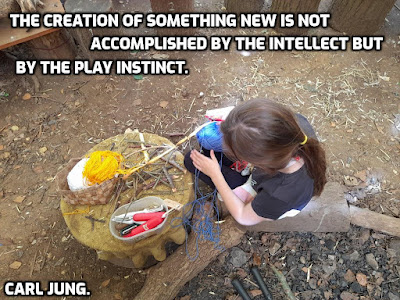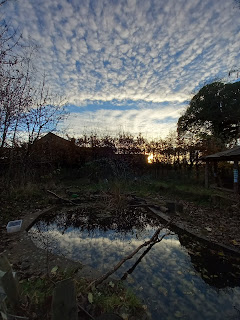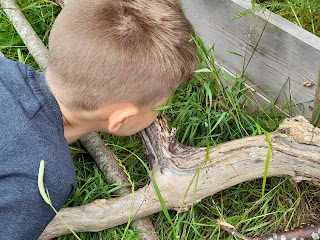Learning To Learn
Many Forest School sessions run within Primary Schools. Trying to keep to the ethos of the pedagogy we know and love while influenced or even pressured, towards doing something very different is not always easy.
It would be virtually impossible to have a tick chart to cover the potential learning outcomes of just these few activities. To choose one or two to focus on would restrict the scope for learning and shift the focus from the child's self-chosen task to the adult seeking evidence.
For those of us who trained while working in education, a career of providing proof of learning is inbuilt. There's an entire philosophical PHD somewhere in the question of whether learning happens without proof! We reduce it down to tick charts, numbers, and letters, and load it as data onto reports and software.
Often 'proof' becomes a product, something 'to take home', something tangible that stands solid as evidence of achievement.
At Chartham, we don't use Forest School as an extension of what is happening inside. We may offer activities to support what's happening in their themes and topics, and the children themselves frequently bring their new knowledge outdoors and ask questions, act it out, and explore it in a different way. What happens in Forest School may support whatever the classes are currently investigating in the curriculum.
Always, we are showing them new ways to learn, better ways to pay attention, and the fun of being curious.
We let them see themselves as explorers, investigators, leaders, teachers, and able learners. We send them back inside knowing that the fresh air and fun have led to endorphins and serotonin boosts, and in turn that the well-being and mental health surge has improved their brains' ability to absorb new information, for their synapses to snap, and improved their ability to take on information.
But breaking it down, can we define what the children gained, for instance, from one hour on Thursday morning?
They chatted with an adult about poppies and their significance (PSHE & History), they took it upon themselves to find more sticks as the quantity dwindled, and then to peel them in preparation for use (critical thinking). Those who knew the technique for wrapping the yarn helped those who didn't (communication, instruction). They chatted socially as they made a pile of poppies for display. They encouraged others to join in.
Those who wanted to learn were shown how to know the two sticks securely (concentration, Fine Motor Skills - dexterity, and muscle development). Then each took on a role as they formed a factory line for production (teamwork, cooperation, collaboration)
Elsewhere, the Dig Pit had filled with rainwater.
The gutters had been moved by a previous group to run tennis balls along, a group came and asked if they could take them to the Dig Pit.
Here, they planned and designed where to put them (D.T.), ensuring the water could move from one to the other without spilling, change directions, and flow on several different levels (engineering) while ensuring the gutters remained higher at the end where they took on water, and lower at the bottom where it would switch to a new gutter (physics).
They tried several setups (experimented and trialed), and altered them if something leaked, missed its target, or stopped moving (troubleshooting).
They then devised a second track to ensure they could send water back to the start (problem-solving), not so that it worked perpetually because
they enjoyed the scooping and the feeding of the 'machine' they had built.
they enjoyed the scooping and the feeding of the 'machine' they had built.
Meanwhile, those children peeling bark from sticks were using peelers (that way more could join in). Children reminded each other to 'peel AWAY from you' when chatting led to a lapse in concentration (H&S, care & concern). They selected the right shape, thickness, and length of twig they felt would work best (maths). They asked for sand paper and improved their product!
As always some children chose to climb trees. They let the adults know when they were going to do so, they carefully chose the tree they wanted to climb, then they observed a path up and proceeded to make their way up... following the safety rules they know by heart. They observed, thought, planned, concentrated, judged, reached, stretched, and use almost every muscle in their body to balance and climb.
They demonstrated an understanding of the instructions they've heard a hundred times!
They tested their courage.
They watched each other with a critical but friendly eye, calling out if they felt the risk had increased, or something had not been noticed.
They talked each other down with care and consideration.
Next to the Dig Pit a Mud Cafe was in full swing. The chefs were demanding ingredients from garlic and onions, to pastry and sugar. They discussed menus and processes. They shared out and took turns with equipment, water, and mud.
They mixed the precise consistency required for their own need (chemistry?!) and experimented with improving whatever they created. Mud is a resource you should never underestimate!
It would be virtually impossible to have a tick chart to cover the potential learning outcomes of just these few activities. To choose one or two to focus on would restrict the scope for learning and shift the focus from the child's self-chosen task to the adult seeking evidence.
There is also no way to ensure every child will explore every activity each session. If we are going to look for evidence of everything the children do we risk interfering too much. If I HAD to ensure each child knew how to mix mud, or channel water, or climb a tree, would that influence the activities I provide? Would it keep me loitering to observe in one spot more, in the hope of witnessing 'proof' of learning? Would it keep me from answering questions, or helping those who have started taking their learning off on a different tangent...?
If I haven't ticked it off - did they not learn or improve these skills?
Whatever the children show an interest in feeds back into planning each week.
We constantly extend activities during sessions, and week on week, and therefore in partnership with the children, we all increase the potential to learn together.
Of course, by activities, I mean playing opportunities, and we influence the play that happens through the activities we provide. If there were no pots and pans would the mud cafe have opened? Without the gutters would children have tried to move the water? Maybe they would. Maybe they would've moulded mud into cakes, maybe they would've dug channels with their hands. Maybe not.
We don't know.
Because we steer the play, we indirectly steer the learning! As open-ended as we may leave it, what we provide is the starting point. Yes, that is activities, and it is also equipment, and it is environment, and it is ratios. and it is attitude, and it is weather, and it is season... Nothing happens in a vacuum!
So having facilitated the opportunity to explore... mud, water, trees, nature, etc, how far we step back and allow children to discover things independently from there is a professional choice, but it should be driven by what makes the session the most successful for the children.
You'll have noticed I frequently avoid using the word PLAY. Not because I don't think it is the most powerful and motivational tool for human development, but because others dismiss it way too quickly. But whatever word is used instead - it is still PLAY!
It is still the evolutionary tool used by all mammals on this planet to learn how to move, learn how to communicate, learn how to rest, learn how to be.
And we're back to the 'L' word again. LEARN. Through play, children learn.
We may cover ALL subjects, and we may support all areas of the curriculum, but we can only do that by allowing children the freedom to learn at will and to play at will (Child-Centred blog here).
Forest School is there to teach children to see themselves as capable learners.
To teach them to BE capable learners.
And that is its own curriculum.












Comments
Post a Comment